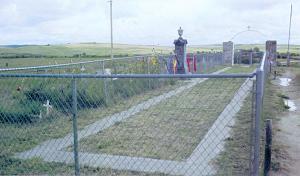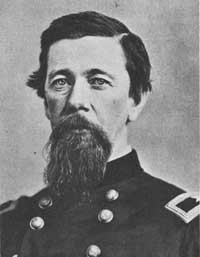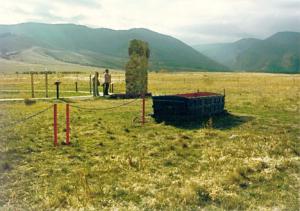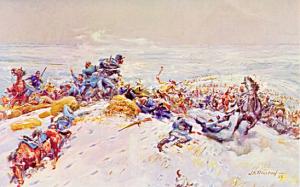Wounded Knee Battleground, South Dakota

Wounded Knee, South Dakota, represents the last significant clash between American Indians and U.S. troops in North America.
Following the introduction of the Ghost Dance among the Lakota Sioux and the killing of Sitting Bull (December 15, 1890), a Miniconjou band of Sioux led by Big Foot fled the reservation. Finally stopped by U.S. troops, they surrendered. The surrender turned into tragedy when shooting erupted.
Then began a virtual massacre of Big Foot’s band on December 29, 1890. Situated on the Pine Ridge Indian Reservation, Wounded Knee Battleground is open to the public. There are markers, and nearby is the cemetery with the mass grave of the Indians who died that day. Casualties: U.S. 25 killed, 35 wounded; Indians 128 killed, 33 wounded.
Slim Buttes, South Dakota

Following the Little Bighorn debacle, Generals Alfred Terry and George Crook took up an unsuccessful summer chase of the Sioux.
As the campaign continued into fall, Gen. Crook’s column found itself out of supplies. Unexpectedly, as part of the column under Capt. Anson Mills was attempting to reach the Black Hills to find supplies, the command stumbled onto the Sioux village of American Horse.
On the evening of September 8, 1876, near the present town of Reva, South Dakota, Mills’s Third Cavalry troopers surrounded the village and attacked it the next morning. Taken by surprise, the village was destroyed and American Horse killed. Other assaults during the fall and winter convinced most of the Sioux and Cheyenne of the futility of fighting the soldiers. The site is on private land.
Killdeer Mountain, North Dakota

Brig. Gen Alfred Sully
The Battle of Killdeer Mountain, fought on July 28, 1864 in western North Dakota, was an outgrowth to the 1862 Sioux discontent in Minnesota.
Leading more than 3,000 volunteers, Brig. Gen. Alfred Sully confronted more than 1,600 Sioux in the North Dakota badlands, representing one of the largest pitched battles in the history of Plains warfare. Sully’s force approached the Indian encampment dismounted in a large square.
The soldiers easily deflected the Sioux charges and drove the warriors from the field. Although casualties were few, Sully was able to destroy vast quantities of Indian stores. Killdeer Mountain Battlefield is operated by the North Dakota State Parks.
Wagon Box Fight, Wyoming

On August 2, 1867, Capt. James Powell with a force of 31 men survived repeated attacks by the Sioux near Fort Phil Kearny, Wyoming Territory.
Powell’s defenders, acting as guards for woodcutters, took refuge in a corral formed by laying 14 wagons end-to-end in an oval configuration. The battle lasted five hours with Powell losing 5 men killed and 2 wounded.
Powell reported killing 60 Indians and wounding 120. The soldiers survived the attacks primarily due to the recent addition of breech-loading weapons. The site is operated by the Wyoming State Parks.
Fetterman, Wyoming

The Fetterman battle was fought near Fort Phil Kearny, Wyoming Territory on December 21, 1866.
Angered at white interlopers traveling through their country, Sioux and Cheyenne forces continually harassed the soldiers at Fort Phil Kearny, constructed to provide emigrant protection along the newly opened Bozeman Trail.
On the morning of December 21, Sioux and Cheyenne warriors were able to decoy Capt. William J. Fetterman and 80 men out of the fort and over Lodge Trail Ridge, four miles away. The carefully planned ambush worked to perfection. Fetterman and every man in his detachment died. The State of Wyoming operates the site.
This website uses cookies that are necessary to its functioning and required to achieve the purposes illustrated in the privacy policy. By accepting this OR scrolling this page OR continuing to browse, you agree to our Privacy Policy